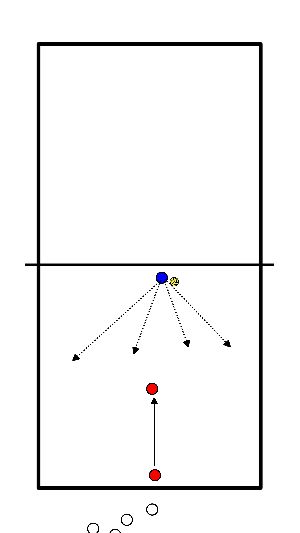Volleyball drills
- The goal is to play the ball in threes. This requires the commitment of every player.
- So line up three players.
- They solve a thrown ball (by the trainer), by playing in threes.
- The first ball is passed to the upper-position.
- The 2nd player, who has the job of upper-player, runs to the upper-place.
- The 3rd player then prepares for the attack.
- At first keep the ball on one side of the net, by not actually hitting the 3rd ball, but catching it.
- Then 3 other players move in to do the same.
- On the other side of the net, the same is practiced with the other half of the team.
- After a while, when the ball is regularly played in threes, the ball is actually played to the other side.
- The team on the other side then plays the ball back in threes.
- And so on; play over as long as possible.
- No scoring, it's about playing in threes.
- Organisation: Make three teams with one ball.
- Execution:
- 2 players stand opposite each other at approx. 5m.
- The third player is "distributor" and stands to the right of the passer.
- Player 1 plays brace to 2nd player and he passes the ball to the right, where the Sv is standing.
- This gives player 2 a setup, which is attacked on player 1.
- Meanwhile, Sv runs to the right side of player 1 to receive the pass there.
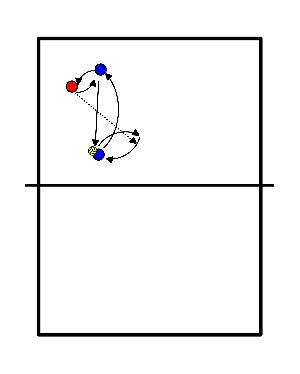
- This exercise is about the movement of the middle block and cooperation with the outside blocker.
- The ball is introduced through service or throw in (by the trainer or team-mate).
- Service is towards the passer.
- Passer brings the ball to the distributor.
- The distributor sets up the attack.
- After 10 attacks the game is continued.
- Players prefer to play on their own position.
- Important for the exercise:
- The playmaker communicates with his attackers about the desired attacking position and speed (especially the alternation between rise and short of the middle attacker).
- Mid block jumps with a rising attack (not full).
- If the ball goes outside, he lands on his left foot and moves outside to set up a two-man block (connecting).
- If the ball is played over middle, the outside blocker steps out to make a pass if the ball falls short or is hit.
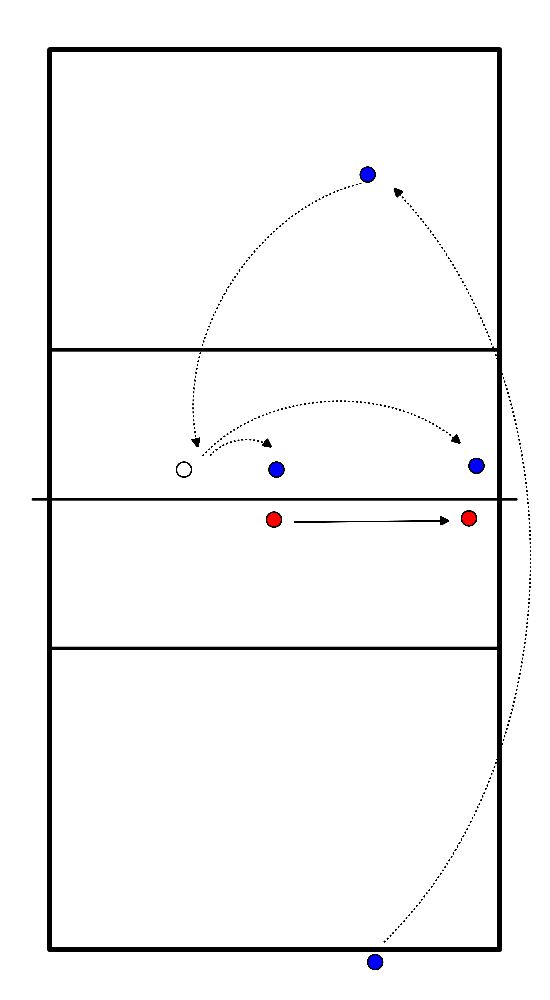
- Organization:
- Trainer throws to playmaker on p2/4 on field A.
- Every 5 setups the players are changed.
- On p4 an attacker stands at the net.
- On court B there is a blocker on p2 and a defender on p5.
- Execution:
- Trainer claps on the ball and throws to.
- The attacker walks back from the net at the moment of hit and attacks the setup on p4.
- She then runs back again and attacks a 2nd ball at p3.
- The block on field B moves with her to p3.
- Running directions:
- Attacker becomes block.
- Block becomes defense.
- Defense retrieves the balls and becomes attacker.
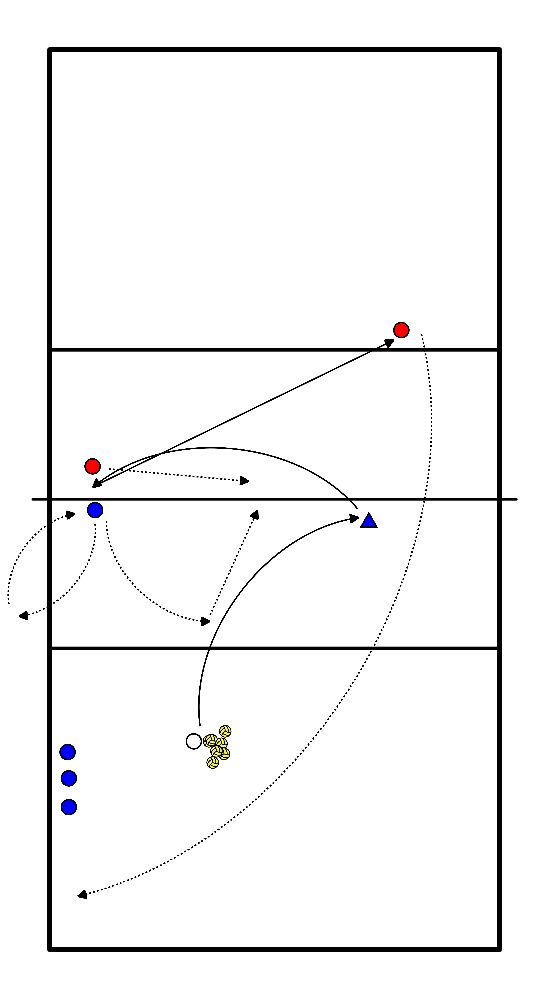
- Organization:
- Players on p2 and p4.
- Other players in 2 rows on 3m line p3.
- Execution:
- The first two players walk to the net and block together on p3.
- Then they sidestep or walk to p2 and p4 and block together with the player who is already there.
- The original player on p2 and p4 make a roll/dive and join the other row.
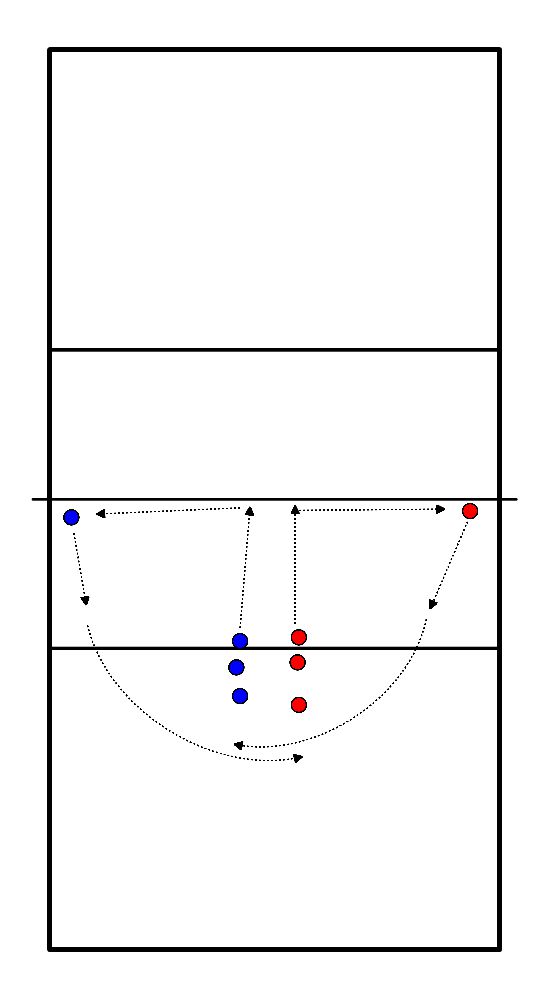
- Organization:
- Field A:
- Sv on p2.
- Attackers on 4 and start at the net.
- Trainer throws in balls.
- Field B:
- Block on p2 and Libero on 5.
- Explanation SBS6. (Stand still, Block Stroke arm to P6)
- Field A:
- Execution
- Tr throws on, setup and attack at 4.
- Block blocks the strike arm and the libero defends the attack if necessary.
- Block stays in place for 5 attacks.
- Expansion:
- Field B:
- Block on p3 connecting to attack on P2.
- If the block is gone before the setup is given, the Sv may play the ball over the net at p3.
- Field B:
- Ball at the net, player on the back line.
- Short ball, 3 metres.
- Shuffle back.
- Long ball 7 meters.
- 6 short balls.
- 5 long balls.
- Last short ball is pancake.
- 5-1 system on both sides.
- Team 1 serves, plays out rally.
- Loser gets a rally ball.
- Other team gets a rally ball.
- Minimum of 2/3 points scored is turn over.
- Service changes every time.
- Important:
- First walk (arms loose and not extended), then stretch and pass.
- Stand still when passing but continue the exercise.
- Throwing (2 players at the same time)
- Move from the left- and right-back to the middle 3-meter and pass; 8 balls 7.
- From left and right back to front 3-meter move and pass; same side 7 balls.
- From left and right halfway side-shuffle. Pass in the middle; same side 7 balls.
- Block at the net and then pass on 3-meter line; same side 5 balls.
- From midfield to left- and right-back bring shuffle pass; loop 5 balls.
- Hit (4 at the same time):
- From left side (3-meter) 1st ball from center attack directly on player; shuffle towards mid-back with immediately a slide attack from outside position.
- From position 5 direct middle attack on player; shuffle to position 6 ball thrown in.
- From position 5 direct mid-attack on player; shuffle to position 4 ball thrown in.
- From the right side (3-meter) 1st ball from mid-attack directly on player; shuffle towards mid-back with immediately a slide attack from the outside position.
- Extended (3 at a time):
- From right long ball from outside attack; short shuffle for diagonal attack. (left player right player alternate)
- 3 passers with random balls. (attack, throw, long balls, short balls)
- Basic setup.
- After processing the service, a rally is played.
- At the net are 3 players with 1 ball.
- On the place of attack a ball is immediately thrown back and has to be drained.
- Play all balls and then rotate through.
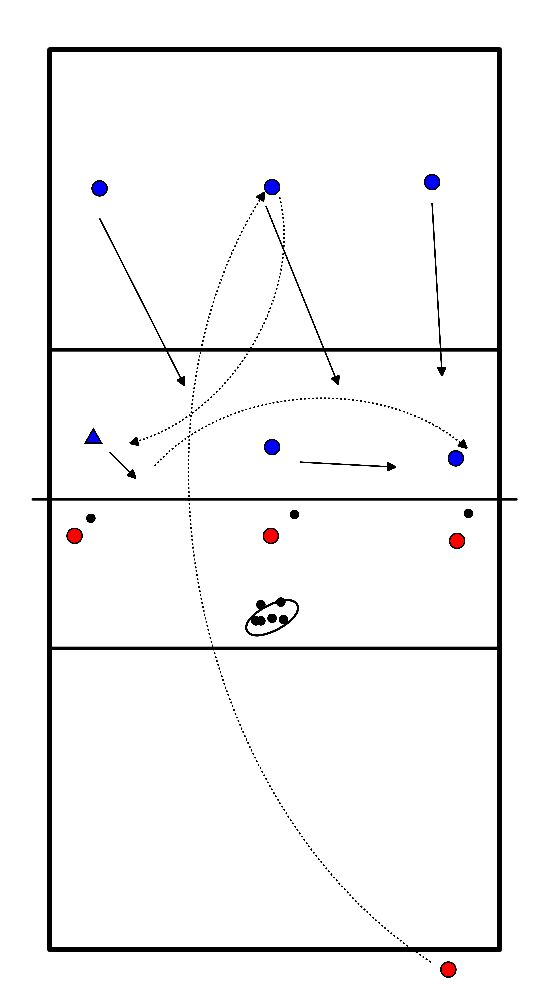
- Players form threesomes.
- Per trio two players at the net with a ball.
- Player A hits the ball (overhand) for a pass before the backline.
- Immediately after that B throws the ball on the three meter line.
- Player C makes a pancake and plays the ball back.
- After 10 times the players turn one spot (A becomes C, B becomes A, C becomes B).
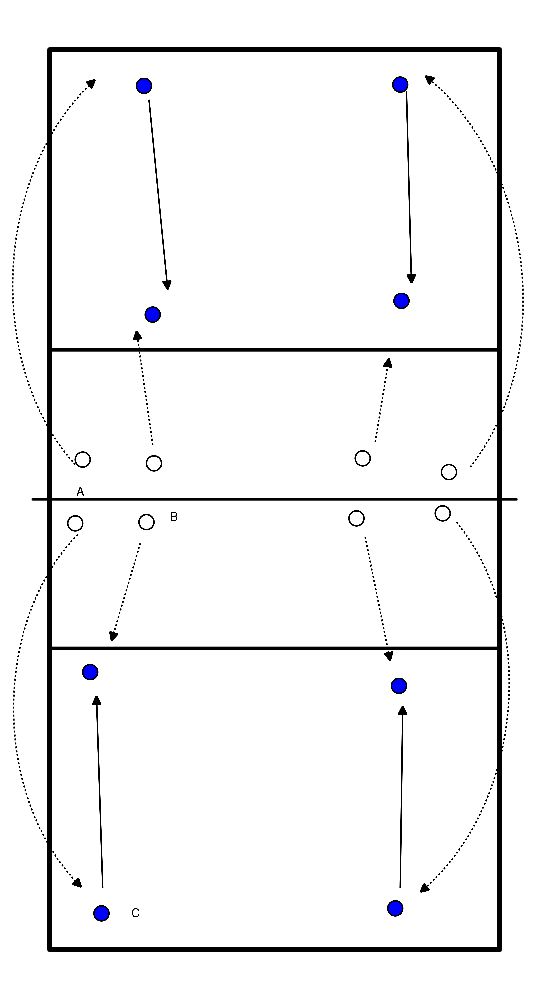
- This exercise trains the split step.
- Players line up behind the back line.
- Trainer or player stands at the net.
- One by one the players walk in from the back line.
- When the trainer hits the ball, the player makes a split step.
- Then he gets the ball on a random spot next to or in front of him.
- Player passes back and retrieves ball if necessary.
- After that the player closes in at the back.
